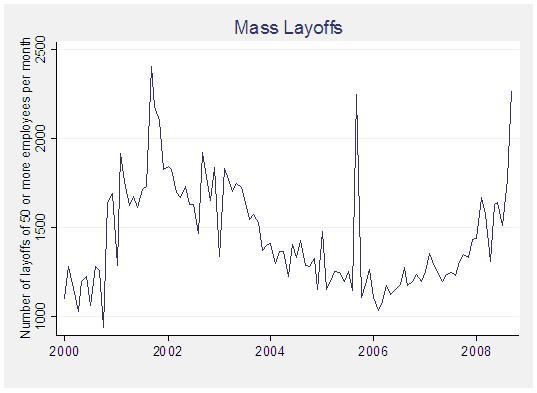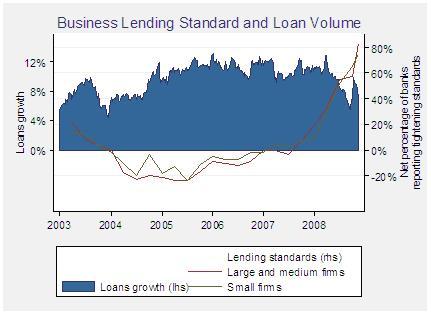One of the leading indicators for the US economic outlook is the number of mass layoffs, defined as the number of instances when firms lay off at least 50 workers. Mass layoffs closely co-move with the business cycle, but also spike after events such as 9/11 or hurricane Katrina (see Figure 1). These short-lived spikes reflect the adjustment of firms to large one-time shocks and are generally not considered as indicators of a systemic increase in unemployment or an indication of a general economic downturn.
A potentially more persistent spike occurred during September 2008, when mass layoffs rose to their highest level since 9/11. Indeed, the data for October show that mass layoffs remain near record highs and that mass layoffs in manufacturing have even increased during Octoberi. This pattern could reflect the one-time adjustment of employment in industries that are directly affected by the financial crisis, for example finance and constructionii. However, it could also be a sign that the financial crisis, via the increased cost of obtaining external finance, now affects the economy at large.
Figure 1 Number of US layoffs of 50 or more employees per month. Monthly mass layoff numbers are from establishments which have at least 50 initial claims for unemployment insurance filed against them during a 5-week period. Source: Bureau of Labor Statistics (BLS).
Indeed, US data show (see Figure 2) that banks currently apply very high standards when giving out loans to non-financial firms. Despite the continuous tightening of lending standards, the volume of loans to the non-financial sector had been growing at high rates until the first quarter of 2008. In July 2008, and hardly by accident coinciding with the spike in mass layoffs, credit growth dwindled. While the situation – due to the massive interventions by governments and central banks - has eased somewhat, the high cost of capital is likely to persist in the near and mid-term future. Therefore, the US is in danger of a severe and prolonged recession if current labour market developments indeed do reflect the consequences of tighter credit supply rather than the one-time direct fallout of the crisis.
Figure 2 Year-to-year percentage change of gross loans, weekly data (area, lhs). Net percentage of senior loan officers reporting tightening lending standards (lines, rhs). Source: Federal Reserve.
In this column, we examine the extent to which the high cost of obtaining external funds has affected employment in US industries using the measure of external financial dependence developed by Rajan and Zingales (1998). We document that employment in sectors that are relatively more in need of external finance has indeed decreased to a much larger extent than employment in sectors less dependent on external sources of financing. In the aggregate, our results suggest that the increasing cost of external finance can account for much of the decline in employment witnessed in US industry since August 2007.
External financial dependence and the impact of crises
Non-financial firms interact with banks every day to finance their current operations and future investments. They are, therefore, directly affected by the health of the financial system. Economic research has long argued for a strong relation between financial markets and general economic development. In a seminal work, Rajan and Zingales (1998) utilise the variation in external financial dependence across sectors to identify the effect of financial development on economic growth. They document that sectors that are relatively more in need of external finance develop disproportionally faster in financially more developed countries.
Subsequent work has used Rajan and Zingales’ measure of financial dependence to investigate how the business cycle (see Braun and Larrain (2004)) and financial crises (Dell’Ariccia et al. (2004) and Klingenbiel et al. (2002)) affect different industries. In particular, the argument is that in times when credit is scarce and expensive, sectors with little need for credit reduce their economic activity much less than sectors with high need for credit. We apply this insight to evaluate the effect of the current financial crisis on the labour market.
Results: spiking unemployment made on Wall Street
Figure 3 plots the percentage growth rate of employment for 39 US industries from mid 2006 to September 2008. The 39 industries, listed below in Table 2, had around 41 million employees in August 2007. Figure 3 plots the annualised quarterly growth rate of employment for sectors with above-median and below-median external financial dependence. While employment growth declined in all firms after August 2007, the decline was much more pronounced in industries that are more dependent on external finance. Employment in the more financially dependent firms grew by around 0.6 percentage points in the middle of 2006, yet decreased by over 5.8 percentage points (annualised) in the 3 months leading up to September 2008. In contrast, in sectors with low financial dependence, the turnaround in the growth rate of employment was much milder, from around plus 0.9 percentage points in July 2006 to minus 3.5 percentage points in September 2008.
Figure 3 Plots the annualised quarterly log change in total employment for firms with above and below median external dependence. Source: BLS and Rajan and Zingales (1998).
The financial crisis has caused a decrease in overall employment, but this pattern was much more pronounced in firms that rely on external capital to finance their operations. This divergence in employment growth rates seems to have happened shortly after August 2007.
Table 1 examines whether this pattern is statistically significant. In Column 1, the dependent variable is the change in the growth rate of employment, i.e., the growth rate of employment in the 12 months leading up to September 2008 minus the same growth rate in the 12 months leading up to September 2007. The coefficient is negative, significant, and economically very large. Financial dependence is taken from Rajan and Zingales (1998) and has a standard deviation of 0.1. A one-standard-deviation difference in external financial dependence is associated with a decrease in the growth rate of employment of 0.1*0.164 or 1.64 percentage points over the last year. Also the R2 of the model is high: financial dependence alone can explain 25% of changes in employment growth rates.
Table 1 The Impact of the Financial Crisis on Firms with various Financial External Dependence
| |
(1) |
(2) |
(3) |
(4) |
(5) |
| |
Change of y/y growth rate |
Panel estimation w. post-crisis dummy |
Post crisis divergence in emp. growth |
Controlling for sector-specific trends |
| |
since 08/2007 |
03/2000-03/2001 |
|
|
|
| Estimation type: |
(1) and (2) OLS |
(3) to (5) Panel with Fixed Effects |
| Dependent variable: |
y/y ch. in emp. growth rate |
Monthly growth rate of emp. (log change) |
| Industry financial dependence |
-0.164 |
-0.002 |
|
|
|
| |
[0.044]** |
[0.059] |
|
|
|
| Dummy (t>07/2008) |
|
|
-0.1432% |
0.1745% |
0.3368% |
| |
|
|
[0.0320%]** |
[0.1274%] |
[0.1355%]* |
| Dummy (t>07/2008) *Industry |
|
|
|
-1.5666% |
-1.61416% |
| financial dependence |
|
|
|
[0.5418%]** |
[0.5760%]* |
| Trend (month) |
|
|
|
|
-0.14% |
| |
|
|
|
|
[0.04%]** |
| Trend (month) *Industry |
|
|
|
|
0.0007% |
| financial dependence |
|
|
|
|
[0.0017%] |
| Fixed effects |
- |
- |
y |
y |
y |
| Sectors |
|
|
39 |
39 |
39 |
| Observations |
39 |
39 |
8736 |
8736 |
8736 |
| R-Squared |
0.245 |
0.003 |
0.002 |
0.006 |
0.019 |
Notes: Table 1 examines the relation between external financial dependence from Rajan and Zingales (1998) and the growth of employemnt in 39 US manufacturing sectors. The depedent variable in column 1 is the change in the y/y growth rate of total employment, i.e. the y/y growth rate of employment from 09/2007 to 09/2008 minus the y/y growht rate from 08/2006 to 08/2007. The dependent variable in column 2 is the y/y growth rate of employment from 04/1999 to 03/2000 minus the y/y growth rate from 04/2000 to 03/2001. In the panel estimations of columns 3 to 5, the dependent variable is th emonthly log-change in the sector's employment. Columns 3 to 5 include fixed effects by sector. Employment data is from the BLS. Heteroschedasticity-robust standard errors in brackets; * significant at 5%; ** significant at 1%.
Is this divergence in employment growth across groups with different need of financing specific to the current economic situation? Braun and Larrain (2004) argue that sectors with high financial dependence generally co-move with the business cycle. Following this reasoning, the results presented in column 1 could also be a result of the general cooling of economic activity that had already begun before the financial crisis. To compare the results presented so far with the general effect of the business cycle, we repeat the exercise of column 1 for the last economic downturn in 2001. Rather than comparing employment growth rates before and after August 2007, we compare growth rates before and after April 2001, one month after the start of the last US recession (as defined by the NBER). In sharp contrast to the point estimate in Column 1, we find a very small and insignificant difference in how the employment of financially more and less dependent firms evolved during the last economic downturn, implying that the labour market effect found in Column 1 is specific to the current financial crisis.
In Columns 3 to 5, we evaluate the decrease in employment over time. In all three fixed-effects panel estimations, the dependent variable is the monthly growth rate of employment (not annualised). Since the analysis is in first differences, all sector-specific trends in employment are included in the fixed effects. All three estimations include a “post July 2007 dummy” equal to one in August 2007 and afterwards. Column 3 includes only the post July 2007 dummy. Compared to the rest of the sample (01/1990-07/2007), the growth rate of employment was 0.14 percentage points lower in the 13 months since the start of the crises.
Column 4 reveals that the decrease of employment growth was not uniform across sectors, but strongly related to financial dependence. In Column 4, the interaction of the post-crisis dummy with the measure of external financial dependence is added to the regressioniii. The interaction coefficient is negative, implying that financially more dependent sectors experienced a much steeper decline in employment once the financial crisis hit the economy.
The results in Column 4 could be driven by differences in the trend of employment growth in different sectors that already prevailed before the financial crisis. To check for this possibility, Column 5 adds a time trend to the estimation and also allows for the time trend to vary with financial dependence. Again, it is noteworthy to point out that the analysis is in first differences, and that therefore, inclusion of these variable accounts for the fact that the pre crisis-trend in the growth rate itself (the second difference) could be related to financial dependence. We find that there seems to have been a general downward trend in employment growth since the start of the 1990s. More importantly, this downward trend did not differ across sectors with low or high external dependence. Consequently, the coefficient of the interaction of the post-July 2007 dummy and the sector’s financial dependence is unchanged.
An example is in order to highlight the magnitude of the effect of the financial crisis on employment. The “Transportation Equipment” industry has a level of external financial dependence of 0.32, while the “Chemicals” sector has a level of external financial dependence of 0.14. The coefficient in the estimation of Column 4 suggests that the transportation equipment industry should have shed 1.57%*(0.32-0.14), or around 0.28 percentage points more employment than the chemical industry per month and thus 3.65 percentage point in total during the 13 months since the start of the crisis. Indeed, employment in the transportation equipment industry contracted by 7.9% since August 2007, while employment in the chemicals industry only contracted by 1.4% over the same period. Thus, financial dependence can explain a substantial fraction of the decreasing employment in the transportation equipment industry witnessed during the last year.
Estimating the aggregate employment impact of the financial crisis
How would the labour market have evolved had the crisis not occurred? We next predict the model of Column 4 in Table 1 setting both the post-July 2007 dummy and the interaction of this dummy with financial dependence to zero for all months. We then compare the predicted job losses to the actual ones in Table 2.
Table 2 lists the 39 industries covered in this study, the actual job losses that occurred from August 2007 until September 2008. In the last two columns of Table 2, the part of the job losses that can be explained by the financial crisis and the sectors financial dependence are listed. We always present first the absolute numbers and then changes in percent of the August 2007 level of employment.
Overall, of the total decline in employment of 2.72% since the start of the financial crisis, 1.86 percentage points (over two thirds) can be attributed to the effect of the financial crisis on the higher cost of obtaining external finance. When looking at absolute values, the financial crisis seems to explain nearly the entire decrease in employment (1,439,000 of 1,558,800 total decrease in employment), but this is driven by two very large sectors (“Administrative and Waste Services” as well as “Administrative and Support Services”). When excluding these two sectors, 608,000 out 965,000 layoffs can be explained, i.e., again around two thirds.
Table 2 The Effect of the Financial Crisis on the US Labour Market. Sources: Bureau of Labor Statistics, own calculations
| # |
Industry name |
Actual change in employment 08/2007-09/2008 |
in percent of 08/2007 |
Change in emp. attributed to crisis 08/2007-09/2008 |
in percent of 08/2007 |
| 1 |
Logging |
100 |
0.2% |
3,046 |
5.1% |
| 2 |
Specialty trade contractors |
-271,100 |
-5.7% |
-122,907 |
-2.5% |
| 3 |
Wood products |
-55,200 |
-11.3% |
101 |
0.0% |
| 4 |
Nonmetallic mineral products |
-27,800 |
-5.7% |
-12,689 |
-2.5% |
| 5 |
Primary metals |
-9,200 |
-2.1% |
-11,461 |
-2.5% |
| 6 |
Fabricated metal products |
-35,700 |
-2.3% |
-38,622 |
-2.5% |
| 7 |
Machinery |
-1,200 |
0.1% |
-9,060 |
-0.8% |
| 8 |
Computer and electronic products |
-16,600 |
-1.3% |
-32,041 |
-2.5% |
| 9 |
Computer and peripheal equipment |
100 |
0.1% |
-4,712 |
-2.5% |
| 10 |
Communications equipment |
2,500 |
1.9% |
-3,253 |
-2.5% |
| 11 |
Semiconductors and electronic components |
-14,700 |
-3.4% |
-11,137 |
-2.5% |
| 12 |
Electronic instruments |
2,300 |
0.5% |
-11,203 |
-2.5% |
| 13 |
Electrical equipment and appliances |
-9,700 |
-2.3% |
-17,938 |
-4.2% |
| 14 |
Transporation equipment |
-130,100 |
-7.9% |
-71,807 |
-4.2% |
| 15 |
Motor vehicles and parts |
-141,600 |
-15.4% |
-41,728 |
-4.2% |
| 16 |
Furniture and related products |
-49,500 |
-9.7% |
-9,082 |
-1.7% |
| 17 |
Miscellaneous manufacturing |
-7,700 |
-1.2% |
-4,390 |
-0.7% |
| 18 |
Food manufacturing |
-4,800 |
-0.3% |
-10,626 |
-0.7% |
| 19 |
Beverages and tobacco products |
-5,100 |
-2.6% |
-3,732 |
-1.9% |
| 20 |
Textile mills |
-17,400 |
-11.0% |
-3,735 |
-2.2% |
| 21 |
Textile product mills |
-8,800 |
-5.8% |
-191 |
-0.1% |
| 22 |
Apparel |
-16,500 |
-8.1% |
-853 |
-0.4% |
| 23 |
Leather and applied products |
1,800 |
5.3% |
867 |
2.6% |
| 24 |
Paper and paper products |
-9,700 |
-2.1% |
-11,346 |
-2.5% |
| 25 |
Printing and related support activities |
-24,400 |
-4.0% |
-26,143 |
-4.2% |
| 26 |
Petroleum and coal products |
1,200 |
1.1% |
-3,401 |
-3.0% |
| 27 |
Chemicals |
-12,200 |
-1.4% |
-5,887 |
-0.7% |
| 28 |
Plastics and rubber products |
-27,900 |
-3.8% |
8,987 |
1.2% |
| 39 |
Motor vehicle and parts dealers |
-69,300 |
-3.7% |
-48,475 |
-2.5% |
| 30 |
Miscellaneous store retailers |
-12,200 |
-1.4% |
-22,018 |
-2.5% |
| 31 |
Support activities for transportation |
6,100 |
1.0% |
-14,778 |
-2.5% |
| 32 |
Publishing activities |
-28,200 |
-3.2% |
-22,710 |
-2.5% |
| 33 |
Motion picture and sound recording industries |
4,400 |
1.2% |
-9,527 |
-2.5% |
| 34 |
Admin. and waste services |
-306,500 |
-3.7% |
-355,365 |
-4.2% |
| 35 |
Admin. and support services |
-316,100 |
-4.0% |
-475,947 |
-5.9% |
| 36 |
Waste management and remediation services |
9,600 |
2.6% |
-9,061 |
-2.5% |
| 37 |
Arts |
13,900 |
0.7% |
19,819 |
1.0% |
| 38 |
Performing arts and spectator sports |
19,800 |
4.7% |
4,116 |
1.0% |
| 39 |
Repair and maintenance |
-23,000 |
-1.8% |
-50,111 |
-4.0% |
| TOTAL (percentages are unweighted) |
-1,588,000 |
-2.72% |
-1,439,000 |
-1.86% |
| Total excluding sectors 34 & 35 |
-965,400 |
-2.66% |
-607,688 |
-1.69% |
Conclusion
In times when banks find it hard to re-finance themselves, they also reduce lending to their customers, hence impacting real economic activity. The impact of reduced lending on real economic activity is more pronounced in sectors that are highly dependent on external capital. Using sectoral variation in the degree to which firms are dependent on external finance, we document that the higher cost of credit that firms have experienced since the start of the financial crisis can indeed account for much of the decrease in employment in US manufacturing since the start of financial turmoil in August 2007.
We are now witnessing the start of potentially severe real consequences of the financial crisis. Our results suggest that much of these real consequences are driven by credit constraints rather than negative demand shocks or layoffs in sectors that are directly affected by the crisis.
Consequently, our results strengthen the case for measures aimed directly at restoring well-functioning financial markets. However, while reconstructing sustainable financial systems will be necessary, this alone will most probably not be sufficient for leading out of the crisis. Indeed, as the financial crisis enters more deeply into the real economy, also aggregate demand falters, which may justify demand-supporting policies.
Disclaimer: Views expressed in this article do not necessarily reflect those of the Swiss National Bank or the International Labour Organization.
References
Braun, Matias and Borja Larrain (2004), “Finance and the Business Cycle: International, Inter-Industry Evidence”, Journal of Finance, 60(3), pp. 1097-1128.
Dell’Ariccia, Giovanni, Enrica Detragiache, and Raghuram Rajan (2004), “The Real Effect of Banking Crises”, Mimeo, International Monetary Fund.
Klingebiel, Daniela, Randall S. Kroszner, and Luc A. Laeven, and (June 2002), “Financial Crises, Financial Dependence, and Industry Growth”, World Bank Policy Research Working Paper No. 2855.
Rajan, Raghuram G., and Luigi Zingales (1998), “Financial Dependence and Growth”, American Economic Review 88(3), pp. 559-96
Footnotes
i The preliminary data for mass layoffs was released by the BLS on the 22nd of November 2008 and is not included in Figure 1 or any of the regressions presented below.
ii Indeed, the construction sector has been strongly affected by the subprime crisis and recorded a fall of some 660’ 000 jobs from its peak in September 2006. However, as data on the distribution of lay-offs by industry show, lay-offs have spread to large sections of the US economy.
iii Since the estimation includes fixed effects by sector, the coefficient of external financial dependence itself is dropped from the estimation.








